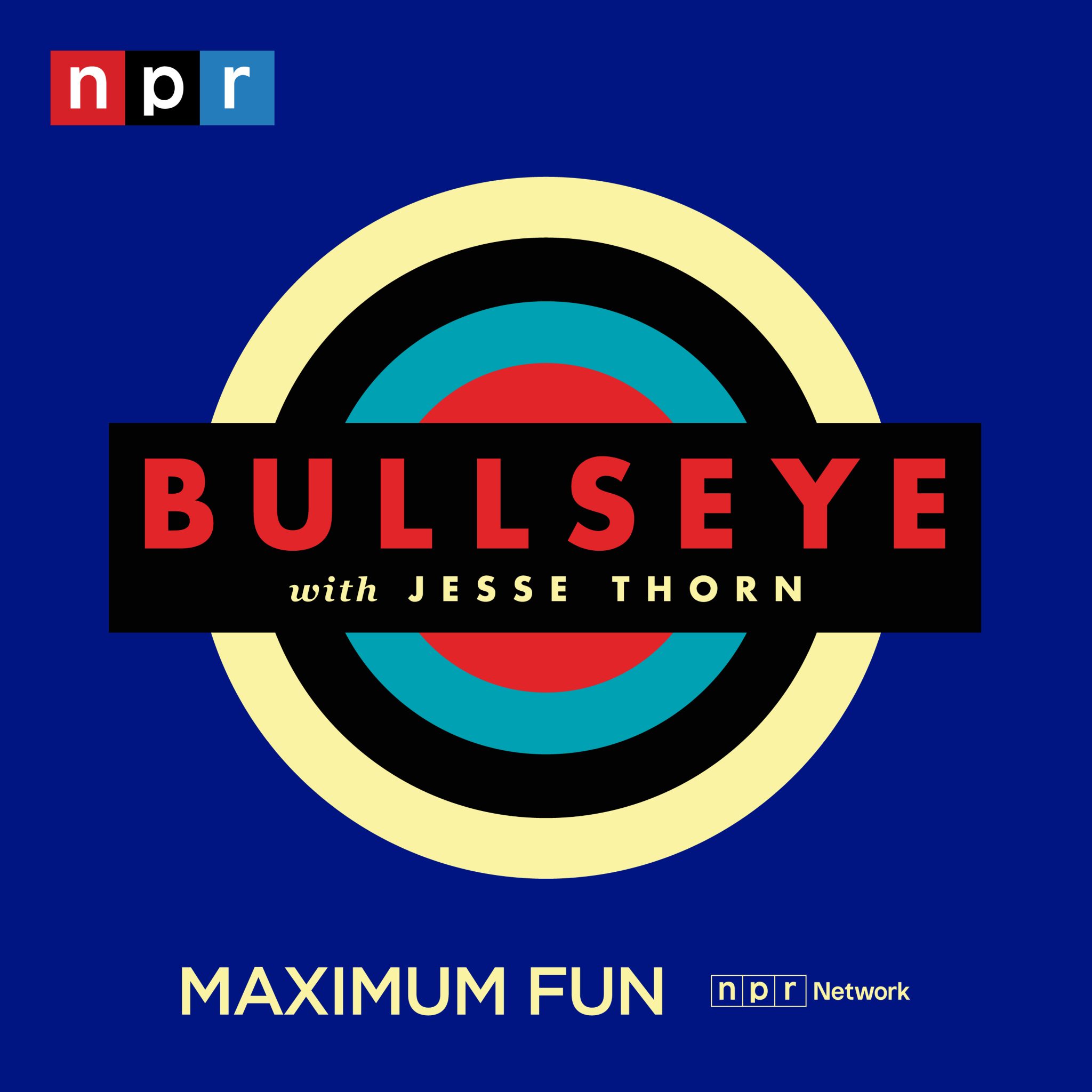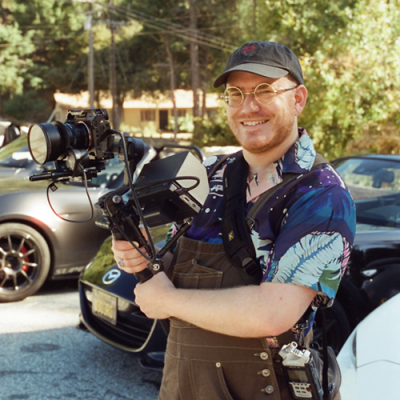Transcript
[00:00:00]
Jesse Thorn: A quick note before we start today’s show. You may have heard that President Trump has issued an executive order seeking to block all federal funding to NPR. This is the latest in a series of threats to media organizations across the country. Whatever changes this action brings, NPR’s commitment to serving an engaged public will never change. Even as paywalls rise elsewhere, we offer this vital resource to everyone regardless of their ability to pay. This is a pivotal moment. It’s more important than ever that every supporter who can contribute comes together to pitch in as much as they are able. Support the news and programming you and millions rely on by visiting Donate.NPR.org.
Transition: Gentle, trilling music with a steady drumbeat plays under the dialogue.
Promo: Bullseye with Jesse Thorn is a production of MaximumFun.org and is distributed by NPR.
Music: “Huddle Formation” from the album Thunder, Lightning, Strike by The Go! Team—a fast, upbeat, peppy song. Music plays as Jesse speaks, then fades out.
Jesse Thorn: It’s Bullseye. I’m Jesse Thorn. Consider for a moment, dear listener, the sequin: a tiny, round piece of plastic smaller than a dime, a little bigger than the head of a screw. If you find one on the ground or the bottom of a drawer, you should probably just toss it, right? But you get 1,000 of them together? It’s something else. You can put ’em on a shoe or little matador jacket. Or how about this? Cher’s outfit from the Oscars in 1986. If you don’t remember, just picture hair that is exploding outward, like a cartoon cat who bit into a live wire; plus a giant, elaborate, sequined headpiece that looks a little bit like—I don’t know, (chuckles) Lisa Simpson. Below that, a diamond patterned bralette covered in black sequins. Below that, a bunch of bare midriff. And then from the hips down, a skirt made entirely of—yes, that’s right—more black sequins. It is an unbelievable outfit. Equal parts insanity and stunning beauty.
That is the specialty of my guest, Bob Mackie. Bob Mackie, the Sultan of Sequins, the Baron of Beads, the ruler of the humble rhinestone. Mackie, who just turned 86 years old, has made a career of dressing big personalities in big outfits. He’s done it as a fashion designer in the real world and as an award-winning costume artist for stage and screen. Which big personalities am I talking about? Well, there’s Cher, for decades—like I mentioned, Madonna, Miley Cyrus, Tina Turner, Bette Midler, Elton John, Lucille Ball, Carol Burnett. Barbie! I mean, literally Barbie. Oh, and do you watch RuPaul’s Drag Race? He was the very first guest judge on that show, and he was also the first person to receive the Drag Race Giving Us Lifetime Achievement Award.
Mackie’s life and career were profiled in a wonderful documentary late last year. It’s called Bob Mackie: Naked Illusion. It covers the era-defining design work he did and the extraordinary life he’s lived. Bob was nice enough to invite us over to talk with him in his stunning, beautiful home. If you’re listening to me on the radio or on a podcast, you can see what I’m talking about by checking out the video of this interview on the Bullseye YouTube page. We were very careful, at his invitation, to get some B-roll of his bathroom. Let’s get right into it: my conversation with the charming and brilliant Mr. Bob Mackie.
Transition: Bright, chiming synth.
Jesse Thorn: Bob Mackie, welcome to Bullseye. I’m so happy to have you on the show.
Bob Mackie: Thank you.
Jesse Thorn: Bob, you have been both a fashion designer—a runway fashion designer—and a costume designer. What’s the difference between those jobs?
Bob Mackie: Huuuge difference. I mean, one you’re designing for a character that’s probably written in a script, and you want that audience to sort of know who that person is when they walk onstage or on camera. And it can really help the writer and the actor if his costume is perfect. Where the other is just for anyone who just sort of likes it and wants to spend the money.
(Jesse laughs.)
It’s just a whole different thing.
Jesse Thorn: I mean, I think there are people who design runway fashion who say they’re like telling a story, expressing conceptual—
[00:05:00]
Bob Mackie: Nooo, no they’re not! They’re just making a cute frock and hope somebody buys it.
Jesse Thorn: It seems like your sympathies here lie on the side of costume design.
Bob Mackie: Well, it does, ’cause that’s what I always wanted to be. It never interested me—I never looked in a fashion magazine when I was a kid. But I looked in all the movie magazines and, you know, theater magazines and all of that. That was more interesting to me.
Jesse Thorn: What’s a dress or outfit that you remember from your childhood?
Bob Mackie: Uhh, that’s hard! Well, actually there was one. It was—I’ve forgotten the name of the movie, but I’ll tell you it was Gene Kelly and Kathryn Grayson and Dean Stockwell playing a child. And he was the son of a sailor. So, Dean Stockwell, who was about my age at the time—although I think he was playing younger than he was—he wore the best sailor suits I’ve ever seen in my life. And I wanted them so badly, but there was just no way. It was all made in the studio work rooms and stuff. And I was really young.
Jesse Thorn: How old are we talking about?
Bob Mackie: Well, we’re probably talking about seven—six/seven. I think. If I’m not mistaken. I don’t know. You know, I could have been—I don’t think I was younger. I think that’s about where I was.
Jesse Thorn: I feel like sailor suit is the classic thing that parents want to put on their children that children don’t want to wear.
Bob Mackie: I always wanted a sailor suit, ’cause I thought if I have to ever go in the service, it’s the only one I’m gonna look right in.
(They laugh.)
You know? I just said, “Oh, no.” And all my uncles wore, you know, army suits and stuff. And I went, (grumbling) “Oh, no, I don’t wanna be—I don’t wanna be them.” What are you gonna say? You know, it’s in your head.
Jesse Thorn: When did you get interested in making a dress and that specific idea of a glamorous gown?
Bob Mackie: I was never interested in making a dress. I was interested in drawing something interesting. And I sometimes would make like my own paper doll. And then I would make a paper doll dress that had those little things that go over the shoulders.
Jesse Thorn: The little tabs?
Bob Mackie: Yeah, tabs. And those were my stars in my shows that I put on, you know. (Laughs.) And Jack Cole, the famous choreographer from the movies in the ‘50s, had a definite style. And so, all of a sudden I had the same style. You know, big numbers that happened in bar rooms in New Orleans or somewhere in the south, you know. It was just what he loved to do. And he did all of Marilyn’s stuff at that time. And Gwen Verdon was his assistant choreographer who could do everything. And she became, you know, a huge Broadway star from being in those movies. She was always featured.
Jesse Thorn: Did you want to be a commercial artist, or a fine artist, or did you already know that you were going to be—?
Bob Mackie: I would’ve been a commercial artist or a costume designer. That was it. Or a set designer. I’m sorry that I didn’t take that further, ’cause I would be making more money today.
Jesse Thorn: Is that where the money is?
Bob Mackie: More than costume design, yeah.
Jesse Thorn: How did you get your first job?
Bob Mackie: I took my portfolio in and got it the first day when I went to Paramount. And the guy was doing a movie in the south of France, and he needed somebody to do his sketches for only the men. It was Glenn Ford and Charles Boyer. That’s a good combination. And you know, usually young fashion or costume designers only draw girls with dresses on. And I kind of was almost there. And they said, “Can you draw men?”
And I said, “Yes!” I didn’t—I wasn’t sure I could really pull it off, but I did it beautifully. I could do it. I could look at a photograph and make it happen. And then he hired me later, and it happened to be at Paramount. And Edith Head was working there, and she’d wander in to see what her guests were doing. They were just renting the space. And she would look at, every day, what I was doing, and she says, “Do you think you could do strippers?”
(They laugh.)
And I said, “Uh, yeah, I think I could.” ‘Cause I had been working at a department store in downtown LA, and there was a big strip palace, burlesque house right near the bus station where I had to take the bus to get home to where I lived.
[00:10:00]
And one day—I was in high school already, and I said, “I’m just gonna see if they’ll let me in.” It was a real quiet afternoon, Saturday afternoon. And I got in! The next weekend, I had all my friends from school—from Pasadena City College—and we all went down to the burlesque house, girls and boys and all of us in the art department. And you know, we knew what naked ladies look like. (Laughs.) It was funny, but we just thought it was funny. So, it was okay.
Jesse Thorn: What was the job that you were getting from knowing how to do strippers?
Bob Mackie: Well, there was a Paul Newman movie made. It was supposed to be in Paris, and they were in a strip club. It was a big flop of a movie. He and his wife, Joanne Woodward, were in it. And, uh—what’s her name? The funny lady from All About Eve? (Sighs heavily.) I can’t remember her name. Thelma Ritter! Thelma Ritter.
And I thought, “Ohhh, Thelma Ritter’s funny. I’ll like this movie.” Because I’d seen All About Eve, and she’s good in that. I think she got an Oscar, or at least nomination.
Jesse Thorn: We’ve got a lot more to get into with Bob Mackie, including the time that he put Elton John in a sequined Donald Duck costume. It’s Bullseye from MaximumFun.org and NPR.
Transition: Thumpy synth with light vocalizations.
Jesse Thorn: Welcome back to Bullseye. I’m Jesse Thorn. My guest is Bob Mackie. He’s an Oscar nominated costume and fashion designer who has worked with—I mean, pretty much anyone who can call themselves a legend. LizaMinnelli, Carol Burnett, Marilyn Monroe, Cher, Dolly Parton, so many others. There’s a documentary about his extraordinary life and career called Bob Mackie: Naked Illusion. You can rent or buy it now on Amazon Prime or Apple TV. Bob and I talked in his beautiful home in sunny Palm Springs, California. And if you don’t believe me? Guess what, twerp?! We got the whole thing on video! Hop over to the Bullseye YouTube page to see our conversation and see what Bob’s beautiful house looks like. It is really something. It’s just an explosion of Bob Mackie in the very best way. Okay, let’s get back into it. Me and Bob Mackie.
One of the clients who come up in the movie about you is Tina Turner.
(Bob confirms with a chuckle.)
And I don’t think you could find— I mean, first of all, Tina Turner is one of my favorite performers of any kind ever.
Bob Mackie: Why not?
Jesse Thorn: But like I also don’t think you could find a more distinctive form, manner of performance. Like, putting a costume on Tina Turner is a really specific task.
Bob Mackie: Yeah, it was! It wasn’t easy, but yet she kind of knew what she wanted, but didn’t.
Jesse Thorn: I mean, she’s so athletic. Like, as a performer. Like, such a dynamic mover.
Bob Mackie: Yeah. Well, when you can see the muscles in the arms and the legs and the— You know, and you just go, “Wow! Look at that! Look at that body on her!”
And she—you know, the last show I did with her, she’d lost a lot of that kind of tone thing, but she was still incredible and funny and lovely and tell stories that just make you laugh and laugh.
Jesse Thorn: It started with her bringing you cheap dresses from Paris and having you chop them into pieces? (chuckles.)
Bob Mackie: Yeah, no, it’s true! It’s true. She would buy these dresses. She’d go shopping for the girls that worked with her, the Ikettes, and buy stuff for them. And half the time they didn’t really fit them right. And things that she would get from couture designers in Paris and in Italy very often didn’t really fit her properly, but she was getting them for nothing. And she was thrilled. (Laughs.) You know, you just—you’re getting free couture clothes, because they all just would go see her and love her. I mean, you know, I always say there are people that, the minute they came out of the womb, they were singing and dancing and telling jokes. They’re just those kind of people in life, and they know what to do with that audience. They get it completely.
Jesse Thorn: I mean, when you take a dress that, you know, you bought at a boutique in Paris and cut the skirt into strings—
(Bob cackles knowingly.)
It is a way of both expressing the kind of intensity of her performance and of highlighting parts of her body that are in full action when she’s performing.
[00:15:00]
Which, you know, her legs were the most famous thing about her. Right?
Bob Mackie: Well, they were long. She was a bit short-waisted. And so, the legs were long, but the body was kind of short. And she had a high butt in the back. And nothing’s better. When they’re good, they’re really good.
Jesse Thorn: And so, when you cut that skirt into strains, you are allowing for her to get her legs up in the air in a way that she couldn’t if it weren’t in strings, and it’s like a frame for those legs. Like, it’s where the action is.
Bob Mackie: Well, but you have to think of all those things. You have to think about what are the good places. We had to show those off for sure. And you know, she’s the one that saw a dress that I did for Raquel Welch, who wanted to dress that kind of was a little bit Tina Turner looking and like a cave woman. And she says, “Could you do that?”
I said, “Yeah! Of course I can. I’ll do it.”
And she went off—she was all over the world doing her act, and she was on the cover of L’Express in Paris. And Tina Turner saw it on the street and called me and said, “I just saw this magazine. There is the best dress I’ve ever seen!”
(Jesse laughs.)
And it was a tribute to Tina Turner, but she didn’t know that. And when she found out that Raquel Welch wanted to look like her, the woman was the happiest woman I’ve ever known. She was so thrilled.
(Jesse laughs.)
And so was Raquel Welch, the fact that Tina liked her dress. ‘Cause it really was like something she could wear.
Jesse Thorn: When you’re making costumes for comedy, which you made a huge amount of for the Carol Burnett Show over more than a decade—
Bob Mackie: Right. It happened that our star happened to be just plain brilliant. She could make you laugh without trying very hard. Was just amazing.
Jesse Thorn: A total genius. And also, very notably beautiful for someone that is that funny. (Chuckles.)
Bob Mackie: She’s just amazing.
Jesse Thorn: But like, when you are making a costume for something that is funny, sometimes the costume is funny, right? Sometimes you get to make the famous drapery dress right from the Gone With the Wind parody where it’s, you know, someone wearing a dress with a curtain rod through it.
Bob Mackie: Well, in the movie it was funny. What happened was funny. You couldn’t—I mean, ’cause the next time you see her, she’s in the most perfectly made movie outfit ever. Everything is perfect. And you know, that isn’t—that’s not true in life at all.
Jesse Thorn: Right. So, in the parody she just shows up literally wearing the drapes. So, sometimes the costume is the funny thing. But when—
Bob Mackie: But you have to have an actress or an actor that just pulls it off, just does just the wrong thing. Just enough. Too much is too much. It’s—you just have to know.
Jesse Thorn: Does that also apply to the outfits?
Bob Mackie: Oh, yeah. Yeah. It just does.
Jesse Thorn: What’s a costume that was particularly challenging on Carol Burnett?
Bob Mackie: Well, that particular one was, because the original gag in the movie—the real Gone With the Wind movie—was terrible. You knew it was gonna look terrible. But it was—the idea was funny, and it continued to be funny.
Jesse Thorn: Did you ever put something on screen that you thought was too much and distracted from the comedy?
Bob Mackie: Sometimes. Not too often, but sometimes. You just have to kind of know how much you can get away with and still have a laugh. And sometimes you don’t have to do very much, because just a little this or a little that can turn your whole idea. You think, “Oh, that’s pretty! Oh no, it’s not. Oh my god, what is she doing in that dress? Oh.” You know, it’s like that. It’s just—it’s different.
Jesse Thorn: So many of the women that you’re most famous designing for—Cher and Mitzi Gaynor, and Carol Burnett, and Bette Midler—they’re all really funny in addition to being beautiful, glamorous, and just standard talented.
Bob Mackie: Yeah. Well, there’s just some that are funny and then some that you wish they were funnier than they think they are. There’s that one too, always.
Jesse Thorn: Okay, which one is that?
Bob Mackie: I am not gonna tell you!
(They laugh.)
No, it’s just sometimes they’re just not funny enough.
[00:20:00]
They don’t—they can’t do that little twist to make you laugh out loud. And they learn. They learn eventually. You know, Martha Raye I used to hate, because she was such a pain to work with, but she was funny.
Jesse Thorn: I mean, I was watching— There are a few clips of Judy Garland in the documentary.
Bob Mackie: Now that woman can be funny.
Jesse Thorn: Yeah, and she has—you know, this is when she’s in her 40s.
Bob Mackie: 42-or-3, when we did that show. We only did one season.
Jesse Thorn: And she’s a really distinctive physical presence, because she’s so small.
Bob Mackie: 5 foot 11.
Jesse Thorn: 4 foot 11.
Bob Mackie: 4 foot 11! I’m sorry. Yeah. 4 foot 11. That’s small!
Jesse Thorn: A really small person.
Bob Mackie: Long legs, short body.
Jesse Thorn: And she has this kind of like wildness to her where she’s almost like careening around. You know what I mean? (Chuckles.)
Bob Mackie: No, you’re right. You watched—it was interesting to see her work in it, in her own way. And she—you know, they could show her a dance number, once, that she’d never seen before—as a child—and she’d go right out and do it exactly right. But children are like that. They learn how to do things, and it’s easy for them. Somehow, they have that kind of brain that works. Mickey Rooney could do that. People like that. You know. And it doesn’t mean they’re gonna turn out to be successful human beings, but sometimes they are.
Jesse Thorn: Well, I would say Judy Garland was a mixed success at being a human being. She was certainly a show business success.
Bob Mackie: Oh yeah. But they made her do—overworked her and—you know, and made her go on diets, and all the wrong things you do to a child. You know. It’s terrible.
Jesse Thorn: I want to ask you about a couple of your most famous designs.
Bob Mackie: (Chuckling to himself.) Oh god. Are they favorites or are they ones you wanna nab me on?
Jesse Thorn: Well, they’re—
(Bob laughs.)
Well, they’re a mixed bag, Bob.
Bob Mackie: Okay. Alright, go for it.
Jesse Thorn: Okay. Well, first of all, some of the most ridiculous—and delightful—are some of the more ridiculous things that you put Elton John in. Like, there’s this moment in the documentary where there’s this conversation about the time Elton John was dressed as Donald Duck. And what seems to be your defense is, (chuckling) “Well, previously we had dressed him as Minnie Mouse.”
(They laugh.)
Bob Mackie: No, but I mean, he was just—he loved it. He had the best time when he was in costume.
Jesse Thorn: Well, it’s great! That’s why he loved it! It was freaking great!
Bob Mackie: And he would start laughing at himself. And then of course, Donald Duck—he couldn’t do the pedals on the piano! Because he had—his shoes are made out of like, you know, flippers that you swim in! And they’re painted yellow. I mean, it was just—it was like impossible.
Jesse Thorn: There’s a lot of shots in the documentary of him in his skintight, sequined, Elton John themed Dodger’s uniform.
Bob Mackie: Right, right. That was one day in his life, and then later on he did it again, but. You know.
Jesse Thorn: So, how do—where do those things come from?
Bob Mackie: Well, it got so he was always wearing a costume when he did a concert. And sometimes the costume would be made in England, because that’s where he was. Or it’d be in LA, where that’s where he was. And I was there—usually there.
I don’t know. You just go for it. You just do the best—and I remember the Donald Duck costume was— His PR agent said, “Why can’t he just wear a uniform? A Dodgers uniform?”
And I said, “Good idea. And we’ll make it all sparkly, and he’ll love that.” And he loved diamonds. He loved jewelry. He spent all his money on beautiful things like that. And give it his gifts, and keep it himself, and look in the drawers, “Isn’t it beautiful?” You know. (Laughs.) You know, everybody’s different, and they have their likes and dislikes.
Jesse Thorn: Okay. Another one is this famous Cher outfit at the Academy Awards. This is when she had been in Silkwood. This was serious Cher.
Bob Mackie: She was down and dirty in most of those movies, you know, and unsuccessful as a human being—not as an actress, but as a human being and—
Jesse Thorn: Right, character-wise.
[00:25:00]
Bob Mackie: And there was always something about her that was fascinating. Whether you believed who she was or whatever, there was just something about it that you couldn’t help but be fascinated with her.
Jesse Thorn: I mean, there’s a picture of her mother in the documentary. Her mother, who was a model.
Bob Mackie: Gorgeous.
Jesse Thorn: Her mother was breathtakingly good looking. And looked like a model, the model that she was. And when I saw that picture of her, I thought, “Gosh, she looks a lot like Cher, but she could never look like Cher.” Like, the fact that Cher is so much more than just beautiful?
Bob Mackie: But Cher was so undone about the fact that she wasn’t as beautiful as her mother or her blonde sister. ‘Cause there were several different husbands and whatever mixed in there. So, her sister looked quite blonde and very different. And Cher always thought she was unattractive. So many of these girls—not all of them, but so many of these girls that have just something about them that they don’t like never forget it in their lives.
Now Cher looked just—if you see a picture of her Armenian father, she smiles like he smiles. She looks like him, except he has a hairy chest. But you know. (Chuckles.) He just—it’s just kinda wild when you think about it, how unhappy as a child she was. ‘Cause she never looked like the popular girls in her school, high school or wherever. And yet, there was so much already— The minute I saw her when she was like—I don’t know—19 or 20, I went, “Wow, look at her. Look at that body. Look at what she can do!”
And she never worked that hard at looking amazing. She just—
Jesse Thorn: She’s so arresting! Like, that’s a thing. Like, you could never walk down the street and not stop to look at Cher.
Bob Mackie: Yeah, I’m sure people were looking at her when she thought nobody was, but that happens when you’re a kid and you don’t look the way you wanna look. You know. Especially girls, I think.
Jesse Thorn: One of the things that I think you said about Cher in the film is that Cher had the energy of holding back a little bit and having the audience come to her. It was like a—I can’t remember the phrase you used, but it was like a, “Hey, check this out. Hey, get a load of this” kind of vibe.
Bob Mackie: She was like that, though. And she was completely comfortable being her, visually; she was just so comfortable with it. And for years, I kept saying, “How did she learn to sing like that? How in the world could she learn to sing like that?” And then I heard a record she made with her mother, (chuckles) and she and her mother were singing exactly alike. That voice was the same from both women.
And then I heard somebody ask her, “Who taught you to sing?”
She said, “My mother.”
You know? It’s just kind of wild, ’cause that’s not a real voice. That’s not a real lady voice. It’s just amazing.
Jesse Thorn: It’s like a visitor from space, like Grace Jones or something.
Bob Mackie: Yeah! No, really. But she never thought of it that way.
Jesse Thorn: A welcome one, to be clear.
Bob Mackie: But she never thought of it that way. It was just the way she sang. And Sonny would kind of, you know, coach her a little bit. You know, and it would get kind of southern or kind of a little Black, maybe. You know, there were just ways of singing, and she would throw it in once in a while. And some of those things stayed in over the years. But interesting how that works out.
Jesse Thorn: The outfit that she wore at this Academy Awards, when she was being serious Cher, was huuuge boots. Like, giant, black boots.
Bob Mackie: Yeah. They were over the knee. Yeah.
Jesse Thorn: Very little between waist and shoulders. And then—
Bob Mackie: Right. Very little. It was below her waist actually, the part that sat on her—the pants or whatever. Her leg things.
Jesse Thorn: (Chuckling.) Yeah, leg things. I think—is that the technical term? You’re the costume designer.
Bob Mackie: Yeah, yeah. Yeah, yeah. Well, they were pants. Okay. And a loin cloth.
Jesse Thorn: Yeah. And the grandest headdress that’s ever existed on a head.
Bob Mackie: Well, you see, for how many years did she do that show? And every week she would be in some exotic outfit. You know, it wasn’t a real outfit, but yet it was. And she said, “You know, nobody’s seen me look this exotic or this strange”—to her, that was strange—“in a long time, and I wanna look like that.” ‘Cause she was pissed off she didn’t get nominated.
[00:30:00]
She was! She was not happy. And of course, she got more attention than anybody ever has for doing, you know, a part that she didn’t even like doing. (Laughs.)
Jesse Thorn: I mean, in a way she’s like not only the ultimate Bob Mackie clothing wearer, because she has worked with you so extensively and so long—
Bob Mackie: But it happened right away. It wasn’t something that developed over time. It happened quickly.
Jesse Thorn: Like, she is someone who so easily wear something. That is the 12-out-of-ten-est garment in history. Make it look completely at home without losing any of its beauty or any of what makes it outrageous.
Bob Mackie: You’re right! You’re absolutely right.
Jesse Thorn: All those things can sit on her at the same time.
Bob Mackie: I have a picture of her dressed from head to toe as Queen Elizabeth I. And it works! Who would think this funny little Armenian girl from the valley—? You know. But it works. She’s amazing.
Jesse Thorn: It must be a great feeling to know that you’ve had these few subjects in your life—like an Elton John or like Cher—where if—
Bob Mackie: Well, Elton just said to me, “Would you make me costumes?”
I said, “Well, what kind of costumes would you like?”
“Well, I like those things that Cher wears.”
And I’m thinking to myself, “Oh god, do we have a drag queen in the works here?” (Chuckles.) No, just likes dress up and have it be glittery and sparkly and, you know, drag on the ground across the stage. Whatever it takes to make it work.
Jesse Thorn: I mean, he’s sort of like a masc— He’s like the masc drag king. Like, he enacts sort insane versions of masculinity.
Bob Mackie: Kind of, yeah. Elton John is just very honest about himself and what he likes and who he likes, and went through a lot of hell in the beginning, and got over it. Thank god.
Jesse Thorn: We’ll finish up with Bob Mackie after a quick break. Stay with us. It’s Bullseye from MaximumFun.org and NPR.
Promo:
Music: Bright, energetic music.
Jeremy Bent: Hey, we’re the Eurovangelists, and it’s the most wonderful time of the year, because the Eurovision song contest is next week!
Oskar Montoya: 37 countries will face off in Basel, Switzerland to determine who has the best song in Europe.
Dimitry Pompée: On our show, we’ve argued about all the songs, and we are heading to Europe to bring you our reactions straight from Switzerland!
Jeremy: And on our next episode, we’re gonna predict who’s gonna survive the semifinals, compete in the grand final, and ultimately win Eurovision 2025!
Dimitry: Albania, baby!
Oskar: It’s Malta.
Jeremy: Uh, Latviaaa!
Dimitry: But we won’t be alone. Glen Weldon of NPR’s Pop Culture Happy Hour will be with us sharing his own predictions. Aaand telling us why we’re wrong.
Oskar: So, make sure you’re ready for Eurovision by listening to Eurovangelists on Maximum Fun, available everywhere you get podcasts.
(Music ends.)
Transition: Thumpy synth with a syncopated beat.
Jesse Thorn: It’s Bullseye. I’m Jesse Thorn. My guest is fashion and costume designer Bob Mackie.
Is your greatest pleasure to have somebody in front of you that you know you could execute your wildest idea with?
Bob Mackie: Well, that’s always good to feel that you can do that. But I think that I could make that happen with almost anybody if they’re a good performer to start with. But you know, that’s just sort of bragging about myself. But there’s times when you just look at somebody and the way they walk, the way they talk, the way they just kind of will say something and they’ll get a laugh. And you go, “(Chuckles.) Okay, I get it.”
Yeah. It’s just—it’s great when that happens.
Jesse Thorn: Your most famous designs are often the biggest and most ridiculous, but what are the—
(Bob chuckles.)
Just because it’s memorable, but what are the designs that you—what is a design that you’ve created that you’re really proud of?
Bob Mackie: I don’t even know at this point. I don’t really know what I— I’ve done so many that you just do it, and you say, “Well, that works! Oh, thank god, we got a laugh! Huh!” You know, and then you go on to the next thing and hope that it’s better. But I don’t have that—there isn’t that particular one.
The one that was the most startling was Cher on the cover of Time Magazine in her semi-see-through dress. At the time, it was like outrageous. ‘Cause Time Magazine had political stars and, you know, leaders of different countries and all these things on the cover. And all of a sudden there she was! Our little girl, you know. And hold on, how did that happen?
(Jesse laughs.)
[00:35:00]
It was just kind of like, “Wow, okay!” And she was that important. At that time, she—any girl in this country that had long black hair and a big nose said, “Everybody tells me I look just like Cher!”
And you go, “Oh, honey. No. It’s a long way. But go ahead.”
(Jesse laughs.)
Jesse Thorn: Now that you’re in your 80s, do you think you’re better at this than you used to be?
Bob Mackie: No. I don’t think I’m better at it. I don’t think I’m better. I think I’d be about the same. I think. You know, I might be wrong about that.
Jesse Thorn: Have you learned things?
Bob Mackie: I’ve learned things. Yeah, you learn things. You learn what’s flattering, what will look great on them and what will not look great on them. There’s always that too, especially if they’re a glamor girl of sorts. And some people just don’t—can’t pull it off the same way.
Jesse Thorn: Well, Bob, I’m so grateful for your time. It was so fun to get to talk to you about your incredible work.
Bob Mackie: Well, thank you. Thank you. I never mentioned Marilyn Monroe. I think I could have been a good Marilyn Monroe designer, but I never got really— I worked on a movie that she didn’t finish, but I was just the sketch artist. And I did draw the sketch for the birthday song to the president.
Jesse Thorn: Okay, tell me— Before we go. We have to wrap, Bob. But I should make you tell me about this.
Bob Mackie: There no—I just—I went in one day, and Jean Louis said, “I have the sketch I want you to do for Marilyn.”
I said, “Well, I thought she got fired from that movie.”
He said, “Oh, she did. But we need this dress.” And he told me what it is, exactly. And I drew it.
In about an hour I was finished, and I said, “Do you need me for anything else?”
He says, “No, we don’t have anything right now.”
And I went home.
Jesse Thorn: Did you see the video of her doing it then?
Bob Mackie: On TV, yeah. Amazing. When that light hits that woman with all these hand-sewn diamonds all over her dress, and you just—and she wanted to wear things like that. Fox wouldn’t let her wear anything that see-through-y or whatever the word would be, because of the calendar situation. And they were afraid that the public would not wanna see her in anything. So, they wouldn’t—every time—any movie she was—it was very decent. It might be glamorous and sexy, but at the same time, nothing was ever hanging out or showing or anything like that.
Jesse Thorn: Did you know what effect it was having when you saw it on screen?
Bob Mackie: Well, you know, in Madison Square Garden, thousands of people. And the ladies were—the men were in suits, and the ladies were like in cocktail dresses—black cocktail dresses and whatever. And pictures of her I had later on—I saw these pictures from cocktail parties in somebody’s apartment. And there, she’s walking around, you know, sort of nude-ish. And all these people were just these regular people from Washington. You know, it was just the craziest thing,
Jesse Thorn: Just a delegate from Delaware is there.
(Bob laughs.)
Bob Mackie: Yes! It’s just—it’s really crazy when you think about it. And she’s just being friendly to everybody and just nice.
Jesse Thorn: Well, Bob, thank you so much.
Bob Mackie: You’re welcome. Thank you. I hope I didn’t go too long.
Jesse Thorn: Not in the slightest.
Bob Mackie, everyone. The documentary of which he’s the subject is called Bob Mackie: Naked Illusion. It’s available to rent or buy now, digitally. And it is totally fascinating.
Transition: Bright, chiming synth.
Jesse Thorn: That’s the end of another episode of Bullseye. Bullseye is created from the homes of me and the staff of Maximum Fun—as well as at Maximum Fun HQ, overlooking beautiful MacArthur Park in Los Angeles, California. This week, I am thinking of my email pen pal, Terry Gross, who is—of course—my public radio hero and has always been very kind to me. And had been supporting her husband, Francis Davis, through a long health crisis that finally ended recently with his passing. Um… I can’t imagine the pain she’s in. Terry, we’re so grateful for you. And we’re thinking of you.
The show is produced by speaking into microphones. Our senior producer is Kevin Ferguson. Our producers are Jesus Ambrosio and Richard Robey. Our production fellow at Maximum Fun is Hannah Moroz. Our video producer is Daniel Speer. We get booking help from Mara Davis. Our interstitial music comes from our pal, Dan Wally, also known as DJW.
[00:40:00]
You can find his music at DJWsounds.bandcamp.com. Our theme music was written and recorded by The Go! Team. It’s called “Huddle Formation”. Thanks to The Go! Team. Thanks to their label, Memphis Industries, for providing it.
You can follow Bullseye on Instagram, TikTok, and YouTube, where you will find video from just about all of our interviews—including the ones you heard this week. And I think that’s about it.
Just remember: all great radio hosts have a signature signoff.
Promo: Bullseye with Jesse Thorn is a production of MaximumFun.org and is distributed by NPR.
(Music fades out.)
About the show
Bullseye is a celebration of the best of arts and culture in public radio form. Host Jesse Thorn sifts the wheat from the chaff to bring you in-depth interviews with the most revered and revolutionary minds in our culture.
Bullseye has been featured in Time, The New York Times, GQ and McSweeney’s, which called it “the kind of show people listen to in a more perfect world.” Since April 2013, the show has been distributed by NPR.
If you would like to pitch a guest for Bullseye, please CLICK HERE. You can also follow Bullseye on Twitter, YouTube, and Facebook. For more about Bullseye and to see a list of stations that carry it, please click here.
Get in touch with the show
People
How to listen
Stream or download episodes directly from our website, or listen via your favorite podcatcher!






